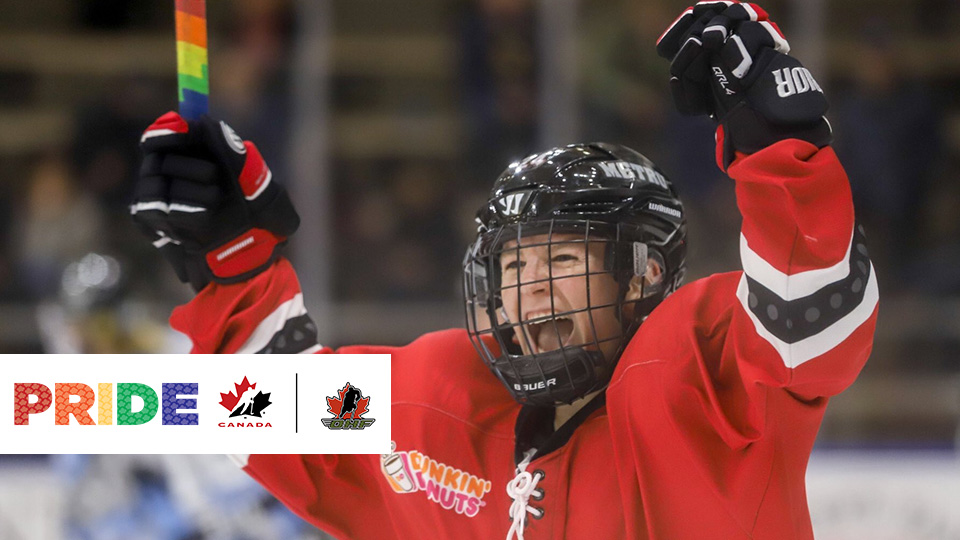A Team Canada alumnus, Isobel Cup champion and transgender advocate, Harrison Browne is using his platform to educate the hockey world and beyond
Hockey provided Harrison Browne with an opportunity to feel openly
comfortable. It also granted him a voice to proudly discuss his journey.
Even in retirement, his message and leadership are important and welcomed,
likely even more acoustically today than when he played.
“I wouldn’t be where I am today without hockey,” says Browne, a two-time
Isobel Cup champion with the Buffalo Beauts of Premier Hockey Federation
(PHF). “I wouldn’t be who I am and have the platform I have without hockey.
“Hockey was the first place that I felt comfortable to be myself and a
place that I cultivated relationships where I felt supported and could
trust people with my identity without judgment.”
As a transgender person and former athlete, Browne appreciates the forum he
now possesses to talk, promote – and especially educate – about LBGTQ+
issues and acceptance.
It’s a podium that today permeates beyond hockey and into mainstream
society.
“I didn’t set out to be an activist,” he says. “But then I saw the impact
of trans visibility and LBGTQ+ visibility and I felt a responsibility to
speak out, be vocal and visible to help anybody that can’t be visible like
I can.
“I get very protective over my community so, yes, I do now consider myself
an activist.”
Since June is Pride Month in Canada and across the world, it is widely used
as an opportunity to support and celebrate LBGTQ+ people through parades,
dances, festivals and other events.
For Browne, Pride Month is all of that and more.
“It’s about celebrating how far we’ve come and recognizing how far we need
to go,” says the Toronto resident. “June is a great reminder of how strong
this community is and how supportive we all are of each other.
“And it’s a great way to celebrate who you are as a person.”
Growing up in Oakville, Ont., Browne began playing hockey when he was nine
years old, a “geriatric start” to the sport in his own words.
Regardless of when it commenced, it concluded as a solid career that lasted
16 years and included playing for Team Canada at the 2011 IIHF World
Women’s U18 Championship and four years of college hockey in the United
States, the last three on scholarship at the University of Maine.
From there, his time in the professional ranks stretched over three seasons
in the PHF (known then as the National Women’s Hockey League), two with
Buffalo and a final campaign in 2018 with the Metropolitan Riveters prior
to retirement.
During his entire professional career, he was the first openly transgender
athlete in a team sport.
Now 29, Browne has shifted his focus to public speaking and a vibrant
acting career, both of which are conduits for trans and LBGTQ+ visibility
and advocacy.
“I’ve been very fortunate,” he says. “After I retired from the game, I’m
still a voice that people look to in the hockey community. I kind of meshed
it with my acting. To be able to have those two worlds align, I certainly
feel like I have a voice. And it’s something that I don’t take lightly and
I’m very proud of.”
Browne’s appearances include celebrity hockey games and functions, keynote
speeches, Scotiabank television commercials and an appearance in an episode
of The Last Man, a TV drama series based on the comic book set by the same
name.
By his own admission, Browne’s new career and schedule doesn’t permit much
time for recreational hockey, something he laments.
However, he will always cherish the game for what it provided prior to his
coming out, but especially after he did in 2016.
He said the PHF, its fans and teammates were extremely supportive during
his social transition in what also became a pivotal period for LBGTQ+
inclusion in sports.
“They all helped me embrace who I am,” says Browne. “When I came out
through hockey, I felt being visible helped a lot of people and the hockey
community really helped me.”
Browne believes women’s hockey has been instrumental in inclusiveness,
acceptance and a beacon for other sports to follow in pursuit of LBGTQ+
visibility and equality.
“The women’s side is exemplary on how other sports and society as a whole
can include the LBGTQ+ community and celebrate people for their
differences,” he says. “And to look at people simply as teammates.”
What does concern Browne in this month of celebration are some additional
barriers that restrict further progressive movement for the LBGTQ+
community.
The recent influence of “non-inclusive” bills and legislation across North
America has created some deep concerns.
In some jurisdictions these laws or bans specifically hinder younger LBGTQ+
people from playing sports and that is a step backwards in our society,
according to Browne.
“It’s unfortunate that it comes with people having to fight back, but I
have seen a lot of progress in the last five years.
“We’re in a moment right now where we’re fighting for our place, but I do
see a lot of hope.”



